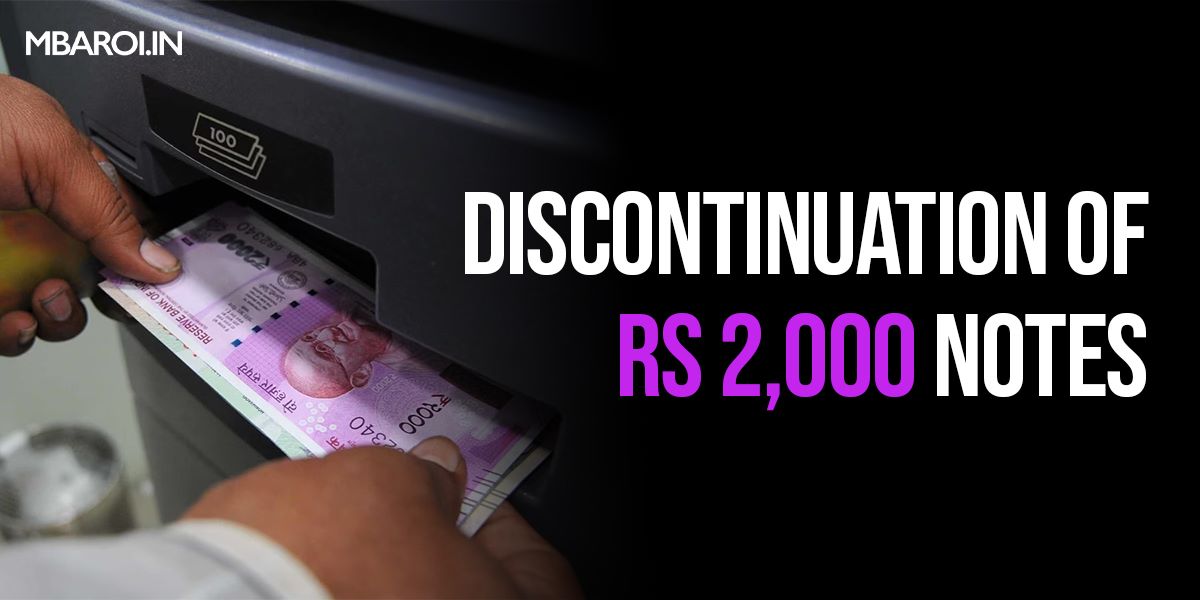The Reserve Bank of India (RBI) has recently decided to withdraw the Rs 2,000 denomination banknotes from circulation. This means that the public will not be able to get these notes from banks or ATMs anymore. However, the existing Rs 2,000 notes will continue to be legal tender, which means that they can still be used for transactions and payments.
- But why did the RBI decide to recall these notes?
- What are the implications of this move for the economy and the public?
- How can you exchange or deposit your Rs 2,000 notes?
In this article, we will answer how the discontinuation of Rs 2000 Notes affects you and more.
The reasons behind the discontinuation:
The RBI has cited three main reasons for recalling the Rs 2,000 notes from circulation:
To fulfill the objective of demonetization:
The Rs 2,000 notes were introduced in November 2016, after the government banned the old Rs 500 and Rs 1,000 notes as part of its demonetisation exercise. The aim was to curb black money, counterfeit currency, and terror financing. The RBI stopped printing these notes in 2018-19, as the purpose of issuing them was fulfilled when enough notes of other denominations were available.
To reduce the circulation of high-value notes:
RBI said that the Rs 2,000 notes were not commonly used for transactions and were mostly hoarded by people. The public used these notes less and less, from Rs 6.73 lakh crore (37.3% of Notes in Circulation) on March 31, 2018, to Rs 3.62 lakh crore (10.8% of Notes in Circulation) on March 31, 2023. The RBI said that there are enough notes of other denominations to fulfill the currency needs of the public.
To implement the Clean Note Policy:
The RBI said that it has been following a Clean Note Policy, which aims to provide good-quality currency notes and coins with better security features to the public. The policy also involves withdrawing soiled notes from circulation and replacing them with new ones. The RBI said that the majority of the Rs 2,000 notes were issued prior to March 2017 and are now at the end of their estimated lifespan of 4-5 years.
What is a Clean Note Policy?
The Clean Note Policy of RBI is a policy that aims to provide good-quality currency notes and coins with better security features to the public. The policy also involves withdrawing soiled, damaged, or counterfeit notes from circulation and replacing them with new ones.
Some of the features of the Clean Note Policy are:
- RBI regularly monitors the quality of currency notes in circulation and sets standards for their acceptability.
- The RBI has set up fast Currency Verification and Processing Systems (CVPS) machines at its offices that can handle, classify and destroy old notes.
- The RBI has directed banks and financial institutions to remove unsuitable or damaged notes from circulation and issue new ones instead.
- Moreover, RBI has advised the public not to write on currency notes or staple them, as it affects their quality and life span.
- The RBI has encouraged the public to use digital payments as a secure and convenient alternative to cash transactions.
The recall of Rs 2,000 notes from circulation is a part of the Clean Note Policy of RBI. The RBI said that these notes were introduced in 2016 to meet the currency requirement after demonetization, but they are no longer commonly used for transactions. The RBI said that these notes are also at the end of their estimated lifespan of 4-5 years. Therefore, the RBI has decided to withdraw these notes from circulation and replace them with lower denomination notes. However, the current Rs 2,000 notes will remain valid for transactions and can be traded or deposited at banks until September 30, 2023.
The impact of the discontinuation of Rs 2000 Notes:
The recall of the Rs 2,000 notes will have some impact on the economy and the public, such as:
Reducing the cash in circulation:
The recall of the Rs 2,000 notes will reduce the total value of cash in circulation by around 10.8%. This may have a positive effect on the formalisation of the economy and the digitalization of payments. However, it may also cause some inconvenience to the people who rely on cash for their transactions, especially in rural areas and informal sectors.
Increasing the demand for lower denomination notes:
The recall of the Rs 2,000 notes will increase the demand for lower denomination notes, such as Rs 500 and Rs 200. The RBI will have to ensure that there is an adequate supply of these notes to meet the public demand. The RBI said that it has enough stock of banknotes in other denominations to meet the currency requirement of the country.
Creating a window for exchange and deposit:
The RBI has given a window of four months, from May 23 to September 30, for the public to exchange or deposit their Rs 2,000 notes. The exchange can be done up to a limit of Rs 20,000 at a time at any bank branch. The deposit can be made without restrictions and subject to existing rules. The RBI has also advised banks to stop issuing these notes with immediate effect.
How to exchange or deposit your Rs 2,000 notes:
If you have Rs 2,000 notes with you, you can either exchange them for lower denomination notes or deposit them in your bank account. Here are some steps you need to follow:
- Visit any bank branch from May 23 to September 30 with your Rs 2,000 notes and valid identity proof.
- Fill up a form with your name, address, account number, and mobile number.
- Hand over your Rs 2,000 notes to the bank official and get a receipt for the same.
- You can exchange up to Rs 20,000 at a time. If you want to exchange more than that, you will have to visit the bank branch multiple times.
- Apart from this, you can also deposit your Rs 2,000 notes in your bank account without any limit. You will get a credit for the same in your account statement.
- You can also approach a Business Correspondent (BC), who is an agent of the bank, to exchange your Rs 2,000 notes. The limit for this is Rs 4,000 per day.
Conclusion
The recall of the Rs 2,000 notes is not a demonetisation exercise, as these notes will continue to be legal tender. It is a routine currency management exercise that the RBI undertakes from time to time. The move is aimed at fulfilling the objective of demonetisation, reducing the circulation of high-value notes, and implementing the Clean Note Policy. The move may have some impact on the economy and the public, but the RBI has assured that it will be non-disruptive and smooth.
The recall of the Rs 2,000 notes is also a step towards a less-cash economy, where digital payments are preferred over cash transactions. A less-cash economy can have several benefits, such as reducing tax evasion, improving financial inclusion, enhancing transparency and efficiency, and promoting innovation and growth. However, a less-cash economy also requires adequate infrastructure, awareness, security, and regulation to ensure that digital payments are accessible, affordable, convenient, and safe for all.
Therefore, the recall of the Rs 2,000 notes is not an end in itself, but a means to an end. It is a part of the larger vision of the RBI and the government to transform India into a less-cash economy and a digital economy.
You May Also Like to Read –
Workforce Reductions – The Impact of Layoffs in the IT Sector
How Neuromarketing is Revolutionizing Advertising Strategies?




